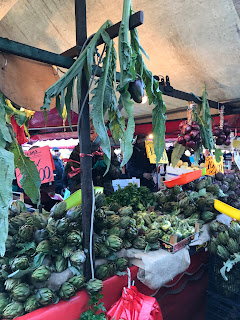We were so fortunate to be able to visit Italy last week, the week leading up to Christmas. We flew into Milan and headed straight to
Padova (Padua), to visit dear friends and old haunts from my
Fulbright, now almost three years ago. Just as I remember it, Padova was precious: charming, narrow streets and bustling piazzas and markets. A bonus: The Christmas lights were absolutely amazing.
 |
| Piazza della fruta, Padova |
 |
| Padova at night |
Of course, a trip to the
Veneto Region requires a visit to Venezia (Venice!). I wrote about
my first visit to Venice during Carnevale, when the water was high and I couldn't get into San Marco. Things were still cold, but less wet, this time around.
 |
| Piazza San Marco, Venezia |
But wait a minute... this post is supposed to be about
Torino (Turin), capital of Piemonte and former capital of the Kingdom of Italy (1861-1865). It was our first time in the Piedmont region, and the views of the snow-covered Alps -even in the city- were stunning. Although I had done my research and made a list of must-sees and must-dos around town, the purpose of our visit was for my husband to reunite with a childhood friend, which turned out to be a blast and, of course, provided us with an amazing, local tour guide.
Torino is a true city with close to one million inhabitants, but its center is very walkable, allowing visitors to experience a good amount of landmarks in a day or two. So, what to do, eat, and see in Torino? Start with
a cafe- you won't have to go far. We were told that this city has more cafes per capita than anywhere... and many of them are historic and so beautiful. We started at the birthplace of the city's signature drink,
Al Bicerin. Bicerin is a mix of espresso, super-thick hot chocolate, and steamed milk or cream. I am not a coffee drinker, but I finished my glass (yes, it's served in a small wine glass), accompanied by not only the typical brioche but
marron glacé (sublime, candied chestnuts) and
gianduiotto, Torino's traditional chocolate (btw, the city is known for both coffee and chocolate, and is home to both Lavazza and Nutella).
We visited a few other cafes during the day... really, they are amazing. One that everyone knows about is
Fiorio, which dates back to 1780. Writers, royalty, and political leaders frequented this cafe over the centuries. We just stopped in for gelato.
 |
| The bar at one of Torino's many historic cafes... help yourself to a tiny glass of water from the fountain |
 |
| The historic Caffe Fiorio |
Of course, one can't just drink coffee and eat sweets all day. Fortunately, Torino also has the largest street market in Italy (so we were told), il
Mercato di Porta Palazzo, which sells everything under the sun, including food from all over Italy. Other
great places to shop are
Via Garibaldi, a long pedestrian street running through the historic center (Piazza Castello to Piazza Statuto), and
Via Po, where you can find all the high-end, "fancy" shops.
 |
Garlic and (below) artichokes at Porta Palazzo market
|
Is it time for lunch yet? Stop by an osteria (we got to go to
il Caffé Vini Ranzini, run by the same family since the late 1800's), to eat some snacks served on a cutting board (al
tagliere) with a glass of wine (dare I start talking about
Piedmont wines?).
 |
| Once (and still) a refuge for laborers after a hard day, Caffé Vini Ranzini still serves hard-boiled eggs at the bar |
I just realized so far I have only talked about food and drink! No problem... as you are wandering from cafe to cafe, it's not difficult to visit all sorts of landmarks in the city center:
Palazzo Reale (royal palace),
Mole Antonelliana, Po River,
museums...
 |
| Ancient city walls from Roman times |
 |
| La Mole Antonelliana, architectural symbol of the city |
... and, of course,
churches, full of stunning Baroque architecture and art.
Overall, although it's not a typical destination on Italy's tourist track, Torino is well worth the trip. Years of being known as the HQ of
Fiat (
since 1899!) gave Torino the reputation as an industrial city (I even heard someone say that Torino is the "Detroit of Italy"). However, there is so much history and culture to be seen here from well before Fiat came on the scene. The 2006 Winter Olympics helped the world
see Torino in a new light, as a vibrant city to be enjoyed. So, be prepared to eat well, drink well, learn and walk a lot as you explore this fun and fascinating place!
 |
| A bedazzled Christmas tree in Piazza del Castello, in front of the Royal Palace |















